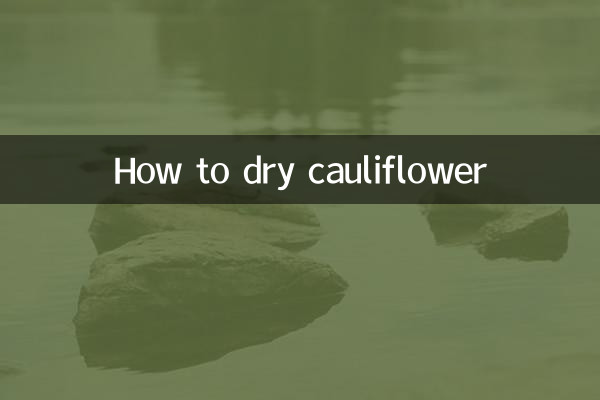How to dry cauliflower
Sun-drying cauliflower is a traditional food preservation method that can extend the shelf life of cauliflower while retaining its nutrition and flavor. In recent years, with the rise of healthy eating, sun-dried cauliflower has become a hot topic again. This article will combine the popular discussions on the Internet in the past 10 days to give you a detailed introduction to the methods, precautions and related data comparisons of sun-drying cauliflower.
1. Steps to dry cauliflower

1.Choose fresh cauliflower: The first step in sun-drying cauliflower is to choose fresh, disease-free and pest-free cauliflower. Fresh cauliflower has bright color, tight buds, and no signs of yellowing or rot.
2.Cleaning and pretreatment: Cut the cauliflower into small pieces and rinse thoroughly with water. In order to remove residual pesticides and impurities, soak in light salt water for 10 minutes.
3.blanch water: Blanch the cauliflower in boiling water for 1-2 minutes, then quickly remove it and place it in cold water to cool. This step will help preserve the color and texture of the cauliflower.
4.dry: Spread the blanched cauliflower evenly on a clean bamboo mat or drying net to avoid overlapping. Choose a sunny and well-ventilated place for drying, and turn it once a day to ensure even drying.
5.storage: After the cauliflower is completely dry, place it in a sealed bag or glass jar and store it in a cool, dry place.
2. Things to note when drying cauliflower
1.Weather options: It is best to choose continuous sunny weather when drying cauliflower to avoid rainy weather causing cauliflower to become moldy.
2.avoid contamination: Pay attention to preventing dust and insects during drying. You can cover the cauliflower with a layer of gauze.
3.degree of dryness: The standard for drying cauliflower is that it is crisp and hard when pinched, with no moisture remaining. If it is not dry enough, it may become moldy during storage.
3. Nutritional comparison between sun-dried cauliflower and fresh cauliflower
| Nutritional information | Fresh cauliflower (per 100g) | Sun-dried cauliflower (per 100g) |
|---|---|---|
| Calories (kcal) | 25 | 200 |
| Protein(g) | 2.0 | 15.0 |
| Dietary fiber (g) | 2.5 | 10.0 |
| Vitamin C (mg) | 48.2 | 20.0 |
As can be seen from the table, the heat and protein content of sun-dried cauliflower are significantly higher than that of fresh cauliflower, but vitamin C will be lost during the sun-drying process.
4. The relationship between hot topics on the Internet in the past 10 days and dried cauliflower
1.healthy eating: Recently, healthy eating has become a hot topic, and many people have begun to pay attention to how to preserve food through natural methods. Sun-drying cauliflower is highly praised because it is simple and easy to do and retains more nutrients.
2.homemade ingredients: With the rising cost of living, homemade ingredients have become a trend. Sun-drying cauliflower is an economical method of preservation and has been adopted by many housewives and health enthusiasts.
3.Eco-friendly living: Reducing food waste is an important part of environmentally friendly living. Sun-drying cauliflower can effectively extend the shelf life of cauliflower, reduce food waste, and is highly consistent with the concept of environmental protection.
5. Suggestions for eating sun-dried cauliflower
Dried cauliflower can be used to stew soup, stir-fry or cook porridge. Before use, it is recommended to soak it in warm water for 30 minutes to restore softness. Sun-dried cauliflower has a rich flavor and is perfect for cooking with meat or other vegetables.
Conclusion
Sun-drying cauliflower is not only a traditional food preservation method, but also conforms to modern people's pursuit of healthy and environmentally friendly life. Through the introduction of this article, I believe you have mastered the techniques and precautions for drying cauliflower. You might as well try drying some cauliflower on the next sunny day to add a healthy and delicious ingredient to your table!

check the details

check the details